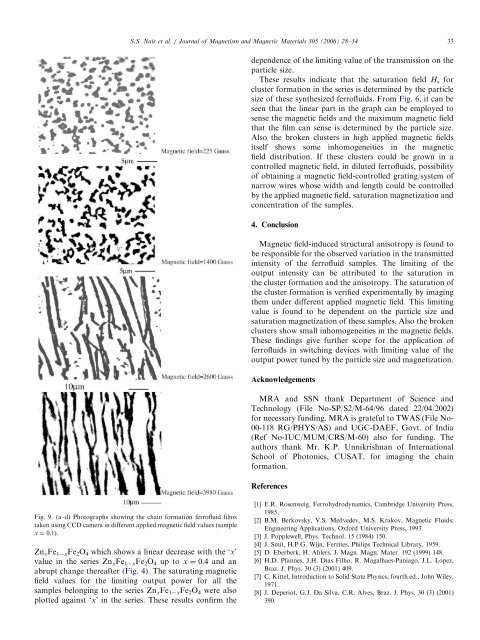Magnetic field-induced cluster formation and variation of magneto ...
Magnetic field-induced cluster formation and variation of magneto ...
Magnetic field-induced cluster formation and variation of magneto ...
Create successful ePaper yourself
Turn your PDF publications into a flip-book with our unique Google optimized e-Paper software.
Zn xFe 1 xFe 2O 4 which shows a linear decrease with the ‘x’<br />
value in the series ZnxFe1 xFe2O4 up to x ¼ 0:4 <strong>and</strong> an<br />
abrupt change thereafter (Fig. 4). The saturating magnetic<br />
<strong>field</strong> values for the limiting output power for all the<br />
samples belonging to the series ZnxFe1 xFe2O4 were also<br />
plotted against ‘x’ in the series. These results confirm the<br />
ARTICLE IN PRESS<br />
S.S. Nair et al. / Journal <strong>of</strong> Magnetism <strong>and</strong> <strong>Magnetic</strong> Materials 305 (2006) 28–34 33<br />
Fig. 9. (a–d) Photographs showing the chain <strong>formation</strong> ferr<strong>of</strong>luid films<br />
taken using CCD camera in different applied magnetic <strong>field</strong> values (sample<br />
x ¼ 0:1).<br />
dependence <strong>of</strong> the limiting value <strong>of</strong> the transmission on the<br />
particle size.<br />
These results indicate that the saturation <strong>field</strong> Hs for<br />
<strong>cluster</strong> <strong>formation</strong> in the series is determined by the particle<br />
size <strong>of</strong> these synthesized ferr<strong>of</strong>luids. From Fig. 6, it can be<br />
seen that the linear part in the graph can be employed to<br />
sense the magnetic <strong>field</strong>s <strong>and</strong> the maximum magnetic <strong>field</strong><br />
that the film can sense is determined by the particle size.<br />
Also the broken <strong>cluster</strong>s in high applied magnetic <strong>field</strong>s<br />
itself shows some inhomogeneities in the magnetic<br />
<strong>field</strong> distribution. If these <strong>cluster</strong>s could be grown in a<br />
controlled magnetic <strong>field</strong>, in diluted ferr<strong>of</strong>luids, possibility<br />
<strong>of</strong> obtaining a magnetic <strong>field</strong>-controlled grating/system <strong>of</strong><br />
narrow wires whose width <strong>and</strong> length could be controlled<br />
by the applied magnetic <strong>field</strong>, saturation magnetization <strong>and</strong><br />
concentration <strong>of</strong> the samples.<br />
4. Conclusion<br />
<strong>Magnetic</strong> <strong>field</strong>-<strong>induced</strong> structural anisotropy is found to<br />
be responsible for the observed <strong>variation</strong> in the transmitted<br />
intensity <strong>of</strong> the ferr<strong>of</strong>luid samples. The limiting <strong>of</strong> the<br />
output intensity can be attributed to the saturation in<br />
the <strong>cluster</strong> <strong>formation</strong> <strong>and</strong> the anisotropy. The saturation <strong>of</strong><br />
the <strong>cluster</strong> <strong>formation</strong> is verified experimentally by imaging<br />
them under different applied magnetic <strong>field</strong>. This limiting<br />
value is found to be dependent on the particle size <strong>and</strong><br />
saturation magnetization <strong>of</strong> these samples. Also the broken<br />
<strong>cluster</strong>s show small inhomogeneities in the magnetic <strong>field</strong>s.<br />
These findings give further scope for the application <strong>of</strong><br />
ferr<strong>of</strong>luids in switching devices with limiting value <strong>of</strong> the<br />
output power tuned by the particle size <strong>and</strong> magnetization.<br />
Acknowledgements<br />
MRA <strong>and</strong> SSN thank Department <strong>of</strong> Science <strong>and</strong><br />
Technology (File No-SP/S2/M-64/96 dated 22/04/2002)<br />
for necessary funding. MRA is grateful to TWAS (File No-<br />
00-118 RG/PHYS/AS) <strong>and</strong> UGC-DAEF, Govt. <strong>of</strong> India<br />
(Ref No-IUC/MUM/CRS/M-60) also for funding. The<br />
authors thank Mr. K.P. Unnikrishnan <strong>of</strong> International<br />
School <strong>of</strong> Photonics, CUSAT, for imaging the chain<br />
<strong>formation</strong>.<br />
References<br />
[1] E.R. Rosenweig, Ferrohydrodynamics, Cambridge University Press,<br />
1985.<br />
[2] B.M. Berkovsky, V.S. Medvedev, M.S. Krakov, <strong>Magnetic</strong> Fluids:<br />
Engineering Applications, Oxford University Press, 1993.<br />
[3] J. Popplewell, Phys. Technol. 15 (1984) 150.<br />
[4] J. Smit, H.P.G. Wijn, Ferrites, Philips Technical Library, 1959.<br />
[5] D. Eberberk, H. Ahlers, J. Magn. Magn. Mater. 192 (1999) 148.<br />
[6] H.D. Pfannes, J.H. Dias Filho, R. Magalhaes-Paniago, J.L. Lopez,<br />
Braz. J. Phys. 30 (3) (2001) 409.<br />
[7] C. Kittel, Introduction to Solid State Physics, fourth ed., John Wiley,<br />
1971.<br />
[8] J. Deperiot, G.J. Da Silva, C.R. Alves, Braz. J. Phys. 30 (3) (2001)<br />
390.

















